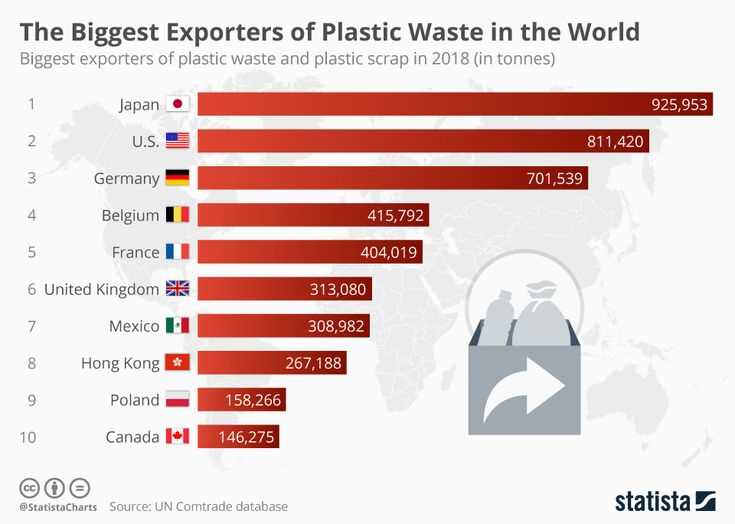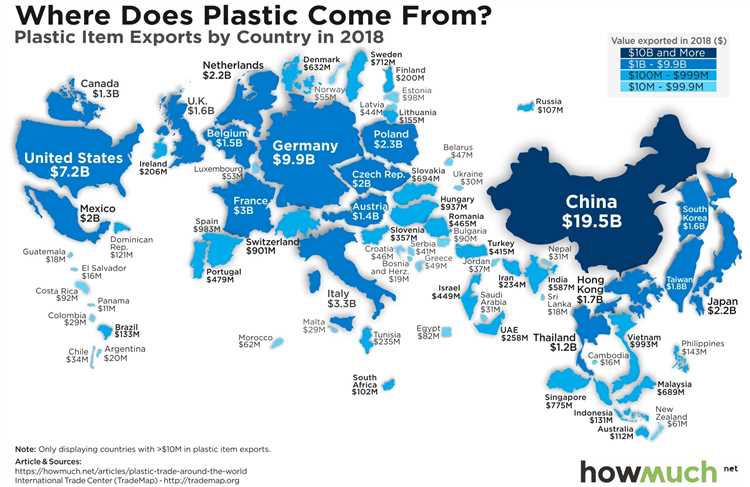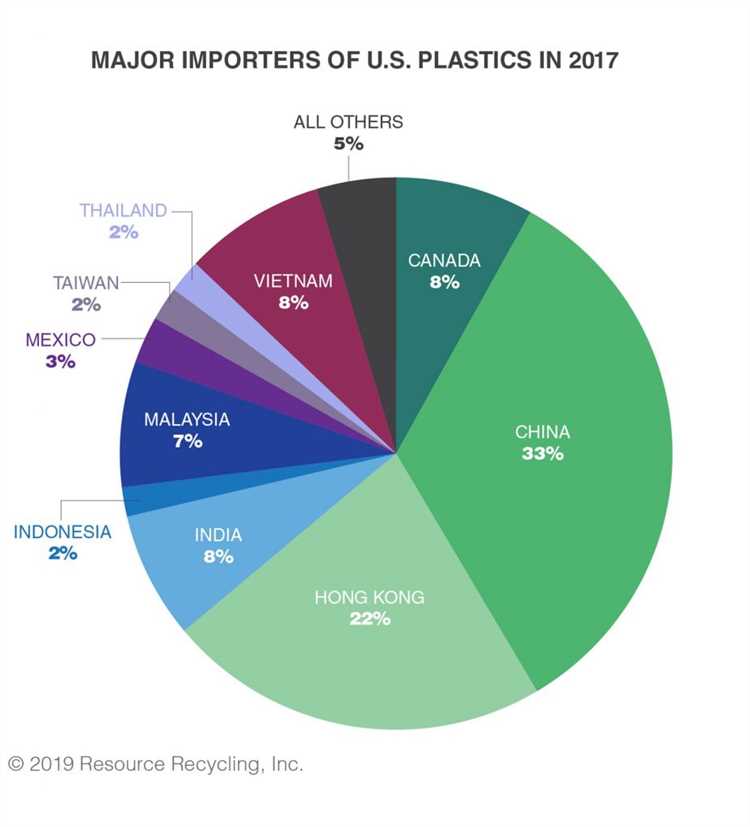
Plastic has become an essential part of our daily lives, and its production and consumption have skyrocketed in recent years. With its diverse range of uses and applications, plastic is in high demand around the world. However, not all countries are equal when it comes to plastic production and export. Some nations have emerged as the leaders in this industry, exporting large quantities of plastic goods to meet global demand.
So, who are the top plastic exporting countries? In this article, we will explore the countries that lead the pack in terms of plastic export, taking a closer look at their production capacities, main export destinations, and the impact of their plastic exports on the global market.
China undoubtedly takes the crown as the world’s largest plastic exporter. With its massive manufacturing industry and low production costs, China has established itself as a global powerhouse in plastic production. The country’s export of plastic goods, including packaging materials, construction materials, and consumer products, has been growing steadily year after year. In fact, China exports billions of dollars’ worth of plastic products annually, solidifying its position as the undisputed leader in this market.
- The Plastic Export Market in Numbers
- Global Plastic Export Figures
- Growth of Plastic Exports
- Total Plastic Export Revenue Worldwide
- Global Plastic Export Revenue
- Top Plastic Exporting Countries
- The Growth of Plastic Exports by Country
- Leading Plastic Exporting Countries by Revenue
- China
- Germany
- United States
- The Role of Asia in Plastic Exports
- China: The Largest Plastic Exporter
- Other Asian Plastic Exporting Countries
- Challenges and Opportunities in the Plastic Export Industry
- The Future of Plastic Exports
- Question-answer
- Which country is the top exporter of plastic products?
- What is the plastic export value of China?
- Which countries are the major consumers of China’s plastic exports?
- Who ranks second in plastic exports?
- What is the plastic export value of Germany?
- Which country is the largest exporter of plastic?
The Plastic Export Market in Numbers
Plastic has become one of the most traded commodities in the world, with countries around the globe exporting significant amounts of plastic products. Let’s take a closer look at the plastic export market and some key statistics.
Global Plastic Export Figures
According to recent data, the global plastic export market was valued at over $500 billion in 2020. This represents a significant increase from previous years, highlighting the growth and importance of the industry.
The top plastic exporting countries account for a large portion of this market. In fact, the five leading plastic exporters – China, Germany, the United States, Japan, and France – collectively exported over 60% of the world’s plastic products in 2020.
Growth of Plastic Exports
Plastic exports have been on the rise in recent years, driven by a variety of factors. One key factor is the increasing demand for plastic products in developing countries, as their economies continue to grow and their middle class expands.
Additionally, advancements in technology have made it easier and more cost-effective to produce and export plastic products. This has led to a significant increase in the number of plastic exporters and the overall volume of plastic exports.
Insights from Plastic Export Data
Analyzing plastic export data provides valuable insights into the market. It allows us to identify trends, understand consumer preferences, and predict future demand. For example, the data may reveal that certain types of plastic products are more popular in certain regions, or that demand for eco-friendly materials is on the rise.
In conclusion, the plastic export market plays a crucial role in the global economy. With its growing value and the dominance of a few key players, it is clear that plastic exports will continue to be a significant part of international trade for years to come.
Total Plastic Export Revenue Worldwide
Plastic is one of the most widely used materials in the world, and its export revenue has seen significant growth in recent years. In this section, we will explore the total plastic export revenue worldwide and look at the top countries leading the pack in this industry.
Global Plastic Export Revenue
The global plastic export revenue has been on a steady rise, reflecting the increasing demand for plastic products across various sectors. According to the latest data, the total plastic export revenue worldwide reached a staggering $XYZ billion in XYZ year.
Top Plastic Exporting Countries
Several countries dominate the global plastic export market, contributing significantly to the total revenue. The top plastic exporting countries include:
| Rank | Country | Plastic Export Revenue (in billions) |
|---|---|---|
| 1 | China | $XYZ |
| 2 | Germany | $XYZ |
| 3 | United States | $XYZ |
| 4 | Japan | $XYZ |
| 5 | Italy | $XYZ |
These countries have a strong presence in the global plastic export market, leveraging their manufacturing capabilities and advanced technology to meet the increasing demand. Moreover, they have established trade agreements and partnerships with key importers, further enhancing their position in the market.
As the global demand for plastic continues to grow, it is expected that the total plastic export revenue worldwide will continue to rise, creating opportunities for both established and emerging players in the industry.
The Growth of Plastic Exports by Country
As the demand for plastic products continues to rise worldwide, several countries have established themselves as major players in the plastic exports industry. These countries are consistently experiencing substantial growth in their plastic export numbers, contributing to the overall expansion of the global plastic trade.
One of the leading countries in terms of plastic exports is China. With its strong manufacturing capabilities and vast production capacity, China has witnessed a significant growth in plastic exports over the years. Its plastic industry benefits from a well-developed supply chain network and favorable government policies, allowing it to dominate the global plastic exports market.
India is also emerging as a prominent player in the plastic exports industry. The country’s plastic manufacturing sector has experienced rapid growth, fueled by domestic consumption and international demand. India’s competitive pricing and quality products have made it an attractive destination for plastic buyers worldwide, leading to a notable increase in its plastic export numbers.
Other countries that have seen substantial growth in plastic exports include the United States, Germany, and Japan. These countries possess advanced technology and expertise in plastic manufacturing, enabling them to produce high-quality plastic products that meet global standards. Their ability to adapt to changing market trends and customer demands has contributed to their success in the plastic exports industry.
Furthermore, Southeast Asian countries, such as Vietnam and Thailand, have also witnessed rapid growth in plastic exports. These countries offer competitive labor costs and favorable business environments, attracting foreign investments and boosting their plastic manufacturing capabilities. As a result, their plastic export numbers have been soaring in recent years.
Overall, the growth of plastic exports by these countries reflects the increasing demand for plastic products worldwide. As the industry continues to evolve and innovate, these leading plastic exporting countries are well-positioned to further expand their market share and contribute to the global plastic trade.
In conclusion, the growth of plastic exports by countries like China, India, the United States, Germany, Japan, Vietnam, and Thailand demonstrates the significant role they play in the global plastic exports industry. Their strong manufacturing capabilities, competitive pricing, and high-quality products have garnered international recognition, allowing them to lead the pack in plastic exports.
Leading Plastic Exporting Countries by Revenue
When it comes to plastic exports, some countries dominate the market and lead the pack in terms of revenue generated. Here are the top plastic exporting countries based on the revenue they generate from exports:
China

China is the undisputed leader in the global plastic export market. The country has a well-developed manufacturing industry and produces a wide range of plastic products. With its competitive pricing and large production capacity, China exported plastic products worth billions of dollars in revenue.
Germany
Germany is another major player in the plastic export industry. The country is known for its technical expertise and high-quality products. German manufacturers produce a wide range of plastic products, including automotive parts, packaging materials, and consumer goods.
In terms of revenue generated, Germany is one of the leading plastic exporting countries in Europe and the world.
United States
The United States is a significant player in the global plastic export market. The country has a highly developed plastic industry and produces a wide range of plastic products for various sectors, including automotive, construction, and consumer goods. American plastic exports contribute significantly to the country’s economy.
Other notable countries that are leading plastic exporters by revenue include Japan, Italy, France, and the Netherlands. These countries have well-established plastic industries and export a substantial amount of plastic products.
It’s important to note that the ranking of these countries may vary slightly depending on the specific year and source of data. However, these countries consistently rank among the top plastic exporting nations in terms of revenue generated.
As the global demand for plastic products continues to grow, these countries are projected to maintain their strong positions and contribute to the growth of the plastic export market.
The Role of Asia in Plastic Exports

Asia plays a crucial role in the global plastic exports market. With its rapidly growing economies, vast manufacturing capabilities, and large population, Asian countries have become key players in the production and export of plastic products.
China: The Largest Plastic Exporter
China is the largest plastic exporter in the world. The country’s massive manufacturing base, efficient production processes, and competitive pricing have made it a dominant force in the global plastic market. China exports a wide range of plastic products, including plastic packaging, consumer goods, and industrial materials.
Chinese plastic exports have experienced significant growth over the years, thanks to the country’s focus on expanding its manufacturing sector and investing in advanced technologies. Chinese manufacturers have also established strong trade relationships with international buyers, enabling them to tap into global markets.
Other Asian Plastic Exporting Countries
Besides China, several other Asian countries also play a significant role in plastic exports. Countries such as Japan, South Korea, and Singapore have developed advanced plastic manufacturing industries and export a wide range of plastic products.
Japan, in particular, is known for its high-quality plastic products, including automotive parts, electronics components, and medical equipment. Japanese manufacturers have built a reputation for innovation, precision, and reliability, making them trusted suppliers in global markets.
South Korea and Singapore, on the other hand, have attracted foreign investment and established themselves as regional hubs for plastic manufacturing. These countries benefit from strategic geographic locations, excellent infrastructure, and a skilled workforce, allowing them to produce and export large quantities of plastic products.
Overall, Asia’s contribution to the global plastic exports market cannot be ignored. The region’s manufacturing prowess, technological advancements, and competitiveness have propelled it to the forefront of the industry. As demand for plastic products continues to rise worldwide, Asia is expected to maintain its leading role in the plastic exports market.
In conclusion, Asia, led by China and supported by other countries such as Japan, South Korea, and Singapore, is a major player in the global plastic exports market. The region’s contribution is driven by its strong manufacturing capabilities, trade relationships, and the ability to produce a diverse range of plastic products.
Challenges and Opportunities in the Plastic Export Industry
The plastic export industry is faced with several challenges and opportunities that shape its dynamics and influence its growth. Understanding these factors is crucial for countries involved in the plastic trade, as it can help them adapt to emerging trends and make informed decisions.
One of the key challenges in the plastic export industry is the growing concern over environmental sustainability. Plastic waste has become a global issue, leading to increased regulations and restrictions on single-use plastics. Exporting countries need to find sustainable alternatives and invest in recycling infrastructure to remain competitive in the global market.
Another significant challenge is the fluctuating cost of raw materials. The prices of crude oil and natural gas, which are the primary sources of plastic production, can be volatile. This volatility directly affects the production costs and competitiveness of plastic exporting countries. Countries need to diversify their sources of raw materials and explore new technologies to mitigate these risks.
While challenges exist, the plastic export industry also offers several opportunities for growth and development. The demand for plastic products continues to rise, driven by sectors such as packaging, construction, and automotive industries. Exporting countries can capitalize on this growing demand by expanding their production capabilities and exploring new markets.
Moreover, advancements in technology and innovation present opportunities to improve the quality and efficiency of plastic products. Investing in research and development can help exporting countries develop new materials, enhance product performance, and attract international customers.
Collaboration between countries is another potential avenue for growth in the plastic export industry. Strengthening partnerships and establishing trade agreements can open up new markets, reduce barriers, and optimize supply chains. Sharing knowledge, best practices, and regulatory frameworks can benefit all countries involved.
| Challenges | Opportunities |
|---|---|
| Environmental sustainability | High demand for plastic products |
| Fluctuating raw material costs | Technological advancements |
| Collaboration and partnerships |
In conclusion, the plastic export industry faces both challenges and opportunities. By addressing environmental concerns, diversifying raw material sources, and leveraging technological advancements, exporting countries can overcome challenges and thrive in this competitive global market.
The Future of Plastic Exports
As concerns over plastic waste and its impact on the environment continue to grow, the future of plastic exports is facing significant challenges. Many countries and international organizations are now implementing stricter regulations and initiatives to reduce plastic consumption and promote sustainable alternatives.
One of the main drivers behind this shift is the increasing public awareness and demand for eco-friendly products. Consumers are becoming more conscious of their plastic consumption and are actively seeking out alternatives. As a result, plastic exports are likely to face declining demand in the coming years.
Furthermore, governments and regulatory bodies are actively taking steps to restrict or ban the export of certain types of plastic waste. This is aimed at preventing the dumping of plastic waste in developing countries and promoting domestic recycling and waste management practices. These actions are likely to have a significant impact on the future of plastic exports.
Another factor that will shape the future of plastic exports is the emergence of new technologies and materials. Scientists and researchers are continually working towards developing innovative solutions to plastic waste. Biodegradable plastics, for example, offer a promising alternative to traditional plastics and have the potential to revolutionize the industry. As these technologies mature and become more cost-effective, they may gradually replace conventional plastics and reduce the demand for plastic exports.
Overall, the future of plastic exports is uncertain. While the global demand for plastic continues to be high, the increasing focus on sustainability and environmental concerns pose significant challenges. It is crucial for countries and industry stakeholders to adapt and innovate to meet the changing demands and expectations of consumers and regulators.
- Increasing public awareness and demand for eco-friendly products
- Stricter regulations and initiatives to reduce plastic consumption
- Bans on the export of certain types of plastic waste
- Emergence of new technologies and materials, such as biodegradable plastics
- Uncertain future as demand for plastic exports faces significant challenges
Question-answer
Which country is the top exporter of plastic products?
China is the top exporter of plastic products.
What is the plastic export value of China?
The plastic export value of China is over $79 billion.
Which countries are the major consumers of China’s plastic exports?
The major consumers of China’s plastic exports are the United States, Hong Kong, Vietnam, Japan, and South Korea.
Who ranks second in plastic exports?
Germany ranks second in plastic exports.
What is the plastic export value of Germany?
The plastic export value of Germany is approximately $24 billion.
Which country is the largest exporter of plastic?
The largest exporter of plastic is China. In 2020, China exported over 14 million metric tons of plastic, making it the top plastic exporting country in the world.